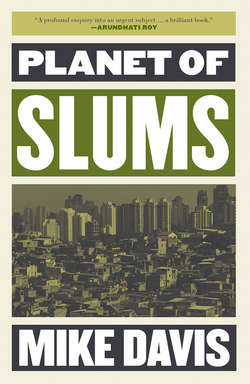Читать книгу Planet of Slums - Mike Davis - Страница 11
На сайте Литреса книга снята с продажи.
Two The Prevalence of Slums
ОглавлениеHe let his mind drift as he stared at the city, half slum, half paradise. How could a place be so ugly and violent, yet beautiful at the same time?
Chris Abani 1
The astonishing prevalence of slums is the chief theme of The Challenge of Slums, a historic and somber report published in October 2003 by the United Nations Human Settlements Programme (UN-Habitat). This first truly global audit of urban poverty, which follows in the famous footsteps of Friedrich Engels, Henry Mayhew, Charles Booth, and Jacob Riis, culminates two centuries of the scientific reconnaisance of slum life which began with James Whitelaw’s 1805 Survey of Poverty in Dublin. It is also the long-awaited empirical counterpart to the World Bank’s warnings in the 1990s that urban poverty would become the “most significant, and politically explosive, problem of the next century.”2
The Challenge of Slums, a collaboration of more than one hundred researchers, integrates three novel sources of analysis and data. First, it is based on synoptic case-studies of poverty, slum conditions, and housing policy in 34 metropolises from Abidjan to Sydney; this project was coordinated for UN-Habitat by the Development Planning Unit at University College London.3 Secondly, it utilizes a unique comparative database for 237 cities worldwide created by the UN-Habitat Urban Indicators Programme for the 2001 Istanbul Urban Summit.4 And thirdly, it incorporates global household survey data that breaks new ground by including China and the ex-Soviet bloc. The UN authors acknowledge a particular debt to Branko Milanovic, the World Bank economist who pioneered these surveys as a powerful microscope for studying global inequality. (In one of his papers, Milanovic explains: “For the first time in human history, researchers have reasonably accurate data on the distribution of income or welfare [expenditures or consumption] amongst more than 90 percent of the world population.”5) If the reports of the Intergovernmental Panel on Climate Change represent an unprecedented scientific consensus on the dangers of global warming, then The Challenge of Slums sounds an equally authoritative warning about the worldwide catastrophe of urban poverty.
But what is a “slum”? The first published definition reportedly occurs in the convict writer James Hardy Vaux’s 1812 Vocabulary of the Flash Language, where it is synonymous with “racket” or “criminal trade.”6 By the cholera years of the 1830s and 1840s, however, the poor were living in slums rather than practicing them. Cardinal Wiseman, in his writings on urban reform, is sometimes given credit for transforming “slum” (“room in which low goings-on occurred”) from street slang into a term comfortably used by genteel writers.7 By mid-century slums were identified in France, America and India, and were generally recognized as an international phenomenon. Connoisseurs and flâneurs debated where human degradation was most awful: Whitechapel or La Chapelle, the Gorbals or the Liberties, Pig Alley or Mulberry Bend. In an 1895 survey of the “poor in the great cities,” Scribner’s Magazine voted Naples’s fondaci as “the most ghastly human dwellings on the face of the earth,” but Gorky was certain that Moscow’s notorious Khitrov district was actually the “lower depths,” while Kipling laughed and took his readers “deeper and deeper still” to Colootollah, the “lowest sink of all” in Calcutta’s “city of dreadful night.”8
These classic slums were notoriously parochial and picturesquely local places, but reformers generally agreed with Charles Booth – the Dr. Livingstone of outcast London – that all slums were characterized by an amalgam of dilapidated housing, overcrowding, disease, poverty, and vice. For nineteenth-century liberals, of course, the moral dimension was decisive, and the slum was first and above all envisioned as a place where an incorrigible and feral social “residuum” rots in immoral and often riotous splendor; indeed, a vast literature titillated the Victorian middle classes with lurid tales from the dark side of town. “Savages,” rhapsodized the Reverend Chapin in Humanity in the City (1854), “not in gloomy forests, but under the strength of gas-light, and the eyes of policemen; with war-whoops and clubs very much the same, and garments as fantastic and souls as brutal as any of their kindred at the antipodes.”9 Forty years later, the new US Department of Labor, in the first “scientific” survey of American tenement life (The Slums of Great Cities, 1894), still defined a slum as “an area of dirty back streets, especially when inhabited by a squalid and criminal population.”10
